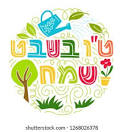Joy and Pruning: Two “Thinking Jew” Conversation Starters for Tu B’Shvat
One of the many goals of our Kinneret 8th Grade is to become what we call a “thinking Jew.” Thinking Jews explore new ideas in Judaism and new trends in the culture of our people both here in the US and in Israel and they integrate that information into their identity..
Thinking Jews also look at the Chagim with more mature understandings, aiming to acquire meaningful lessons they can take with them as emerging adults.
With this in mind, we asked the following questions in our class with respect to Tu B’Shvat. They helped all of us to become better “thinking Jews” and they helped us explore personal meaning in the chag.
1- Simcha:
Rabbi Rabbi Dovid Hofstedter in his book the Doresh David points out that as Tu B’Shvat is the Rosh HaShanah for trees (Mishnah Rosh Hashana 1:1), and we act with joy toward this day. We omit supplicatory prayers like tachanun and we greet each with the chag sameach greeting. Yet, we don’t celebrate all of the other Rosh HaShanahs mentioned in this Mishnah (ones for Kings and tithing). So why would we embrace a holiday that is not for us, but for the tree?
Why act with simcha on the Rosh HaShanah for the Trees?
The Doresh David points out that the Rosh HaShanah for humans is one that, while joyous, is also filled with fear and awe. There is a tone of heaviness that accompanies the high holiday in the fall. However, on Tu B’Shvat, we look at the bare trees and know that they will renew and we will witness nature’s renewal, הִתחַדְשׁוּת. This הִתחַדְשׁוּת inspires us to look at ourselves at nature and renew with a pure joy – a purity that the other Rosh HaShana does not. Tu B’Shvat gives us hope and asks us how we will renew ourselves as we look toward spring. What are we feeling despair about this winter for which we hope for renewal?
2- Pruning:
As we reflect upon the cycles of trees, the act of pruning bears some reflection. Rav Hofstedter points out that we cut off branches for the good of the life of the tree which we are tending.
What personal lesson can we learn from pruning?
Not only is the cutting not harmful to the tree, it is helpful. “Pruning removes dead and dying branches and stubs, allowing room for new growth and protecting your property and passerby from damage.” (The Benefits of Pruning | The Grounds Guys)
We take lessons from pruning into many aspects of our lives. The first is in regards to time. As Oliver Burkman points out in his book, Four Thousand Weeks: Time Management for Mortals, part of the essential human condition is the desire to see our time as infinite, while knowing, all at the same time, that it is not.
By pruning away time pressures in our busy schedules, by saying no to some of our demands, it allows us to say yes to others. Cutting off time commitments that are not in sync with our professional, personal and spiritual priorities, allows us to use our time in ways that are.
We can also take lessons from pruning when it comes to the parts of ourselves and our life that we could do without. Whether it is bad habits, unproductive emotions or destructive relationships, we all must prune. He points out the principle of מוריד כדי להעלות, to cut off in order to thrive and tells us that we all must take part in this exercise in order to thrive. Just as the fruit tree or grapevine needs pruning to thrive, so does each of us. Tu B’Shvat challenges us to think of what we want to shed in order to thrive. Whether it is in the area of time or of our character, what can we prune to allow for flourishing?
Wishing each of us a season of הִתחַדְשׁוּת, of renewal, and of עליה, reaching new heights with the hopes for the spring ahead.

Comments
Post a Comment